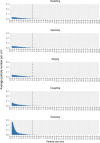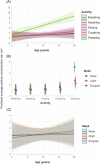The effect of activity and face masks on exhaled particles in children
- PMID: 37324601
- PMCID: PMC10262878
- DOI: 10.1002/ped4.12376
The effect of activity and face masks on exhaled particles in children
Abstract
Importance: Despite the high burden of respiratory infections among children, the production of exhaled particles during common activities and the efficacy of face masks in children have not been sufficiently studied.
Objective: To determine the effect of type of activity and mask usage on exhaled particle production in children.
Methods: Healthy children were asked to perform activities that ranged in intensity (breathing quietly, speaking, singing, coughing, and sneezing) while wearing no mask, a cloth mask, or a surgical mask. The concentration and size of exhaled particles were assessed during each activity.
Results: Twenty-three children were enrolled in the study. Average exhaled particle concentration increased by intensity of activity, with the lowest particle concentration during tidal breathing (1.285 particles/cm3 [95% CI 0.943, 1.627]) and highest particle concentration during sneezing (5.183 particles/cm3 [95% CI 1.911, 8.455]). High-intensity activities were associated with an increase primarily in the respirable size (≤ 5 µm) particle fraction. Surgical and cloth masks were associated with lower average particle concentration compared to no mask (P = 0.026 for sneezing). Surgical masks outperformed cloth masks across all activities, especially within the respirable size fraction. In a multivariable linear regression model, we observed significant effect modification of activity by age and by mask type.
Interpretation: Similar to adults, children produce exhaled particles that vary in size and concentration across a range of activities. Production of respirable size fraction particles (≤ 5 µm), the dominant mode of transmission of many respiratory viruses, increases significantly with coughing and sneezing and is most effectively reduced by wearing surgical face masks.
Keywords: Aerosol; Face masks; Respiratory particles.
© 2023 Chinese Medical Association. Pediatric Investigation published by John Wiley & Sons Australia, Ltd on behalf of Futang Research Center of Pediatric Development.
Conflict of interest statement
Dr. T. Bernard Kinane is a member of the Pediatric Investigation editorial board.
Figures
Comment in
-
How well do face masks worn by children block the release of exhaled particles?Neurosciences (Riyadh). 2023 Jul;28(3):207. Neurosciences (Riyadh). 2023. PMID: 37482383 Free PMC article. No abstract available.
Similar articles
-
Efficiency of Community Face Coverings and Surgical Masks to Limit the Spread of Aerosol.Ann Work Expo Health. 2022 Apr 22;66(4):495-509. doi: 10.1093/annweh/wxab089. Ann Work Expo Health. 2022. PMID: 34668014
-
Efficacy of masks and face coverings in controlling outward aerosol particle emission from expiratory activities.Sci Rep. 2020 Sep 24;10(1):15665. doi: 10.1038/s41598-020-72798-7. Sci Rep. 2020. PMID: 32973285 Free PMC article.
-
Expiratory aerosol particle escape from surgical masks due to imperfect sealing.Sci Rep. 2021 Jun 8;11(1):12110. doi: 10.1038/s41598-021-91487-7. Sci Rep. 2021. PMID: 34103573 Free PMC article.
-
Effectiveness of face masks for the population.Ann Ig. 2021 Jul-Aug;33(4):347-359. doi: 10.7416/ai.2020.2390. Epub 2020 Dec 3. Ann Ig. 2021. PMID: 33258868 Review.
-
Physical interventions to interrupt or reduce the spread of respiratory viruses.Cochrane Database Syst Rev. 2020 Nov 20;11(11):CD006207. doi: 10.1002/14651858.CD006207.pub5. Cochrane Database Syst Rev. 2020. Update in: Cochrane Database Syst Rev. 2023 Jan 30;1:CD006207. doi: 10.1002/14651858.CD006207.pub6. PMID: 33215698 Free PMC article. Updated.
Cited by
-
RSV: an update on prevention and management.Aust Prescr. 2025 Apr;48(2):34-39. doi: 10.18773/austprescr.2025.018. Aust Prescr. 2025. PMID: 40343137 Free PMC article. Review.
References
-
- Coleman KK, Tay DJW, Tan KS, Ong SWX, Than TS, Koh MH, et al. Viral load of severe acute respiratory syndrome coronavirus 2 (SARS‐CoV‐2) in respiratory aerosols emitted by patients with coronavirus disease 2019 (COVID‐19) while breathing, talking, and singing. Clin Infect Dis. 2022;74:1722‐1728. DOI: 10.1093/cid/ciab691 - DOI - PMC - PubMed
Grants and funding
LinkOut - more resources
Full Text Sources


